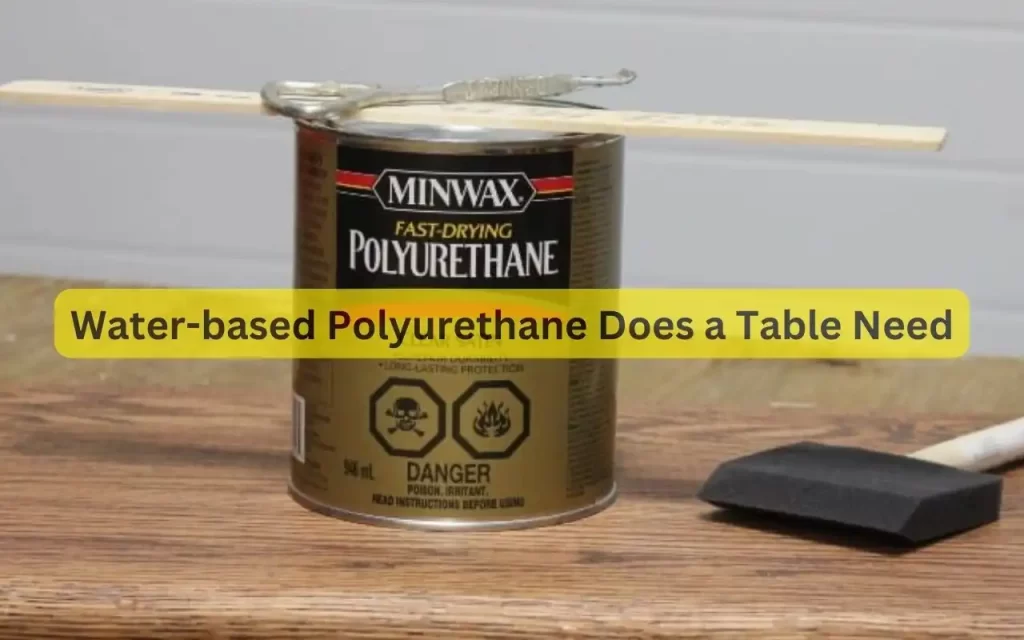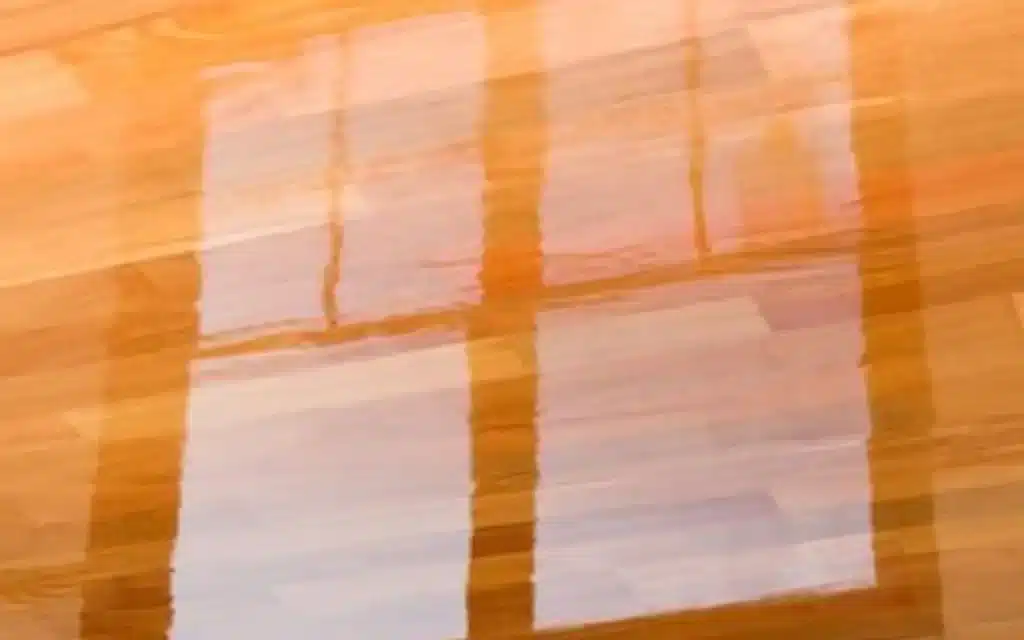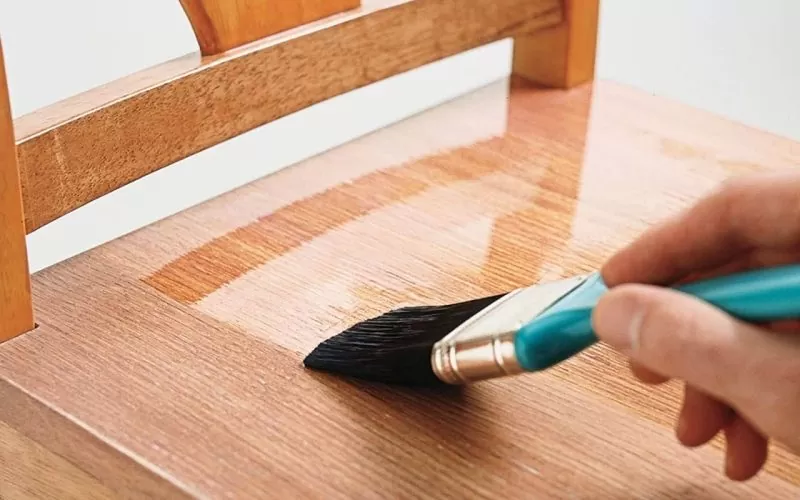It is said that the average person spends around five hours per week eating meals. And if you’re anything like most of the population, a significant portion of that time is spent seated at a table. You can have a good-looking and smooth table with water-based polyurethane.
When you’re in the final stages of refinishing your table, you’ve sanded away the old finish and stained the wood to a beautiful hue. Now you’re ready to apply a clear coat of polyurethane to protect the wood and give it a glossy finish. But how many coats of water based polyurethane on table?
If you’re using water-based polyurethane, the general rule is to apply at least 3 coats.
However, the number of coats you apply will depend on various factors. In this blog post, we’ll discuss how many coats of water-based polyurethane you should apply to your table, as well as some tips on getting the best results.
What factors affect the coats of water-based polyurethane?

Here are the seven factors that affect how many coats of water-based polyurethane a table needs.
Type of wood table
The type of wood your table is made of will affect how many coats of polyurethane you need to apply. because some woods are more porous than others. So it is important to take this into consideration when deciding how many coats to apply.
Softer woods, like pine, will absorb more polyurethane and require more coats. Softwood is more likely to dent and scratch, so it is important to give it a few extra coats of protection. Harder woods, like maple and oak, are less porous and won’t absorb as much polyurethane. As a result, you won’t need to apply for as many coats.
The condition of the table wood
The condition of your table’s wood will also influence how many coats of polyurethane you must apply. If the wood is in good condition, you won’t need to apply as many coats. You apply just one or two coats to protect it from wear and tear.
However, if the wood is in poor condition and has a lot of scratches or dents, you’ll need to apply more than two coats to make sure it’s properly protected.
Type of finish on your table
The end finish you select for your table will also determine how many coats of polyurethane are necessary. Because the finish will determine how durable the table is and how long it will last.
If you choose a high-gloss finish, you’ll need to apply more coats of polyurethane to get the desired result. A high-gloss finish is more susceptible to scratches and scuffs, so it needs more protection. On the other hand, if you choose a low-gloss or satin finish, you won’t need to apply it in 1-2 coats because the finish is less likely to scratch or scuff.
The usage of the wood table
Another factor affecting how many coats of polyurethane you must apply is the amount of traffic the table gets. If the table is in a high-traffic area, like a kitchen, you must apply three coats of polyurethane to protect it from wear and tear. On the other hand, if the table is in a low-traffic area, like a formal dining room, you won’t need to apply a one-two coat.
The climate in your area
The climate in your home will also affect how many coats of polyurethane you need to apply. If you live in a humid climate, you’ll need to apply more coats of polyurethane to protect the wood from moisture.
On the other hand, if you live in a dry climate, you won’t need to apply as many coats because the wood won’t be as susceptible to moisture. You should apply 1-2 coats.
The color of the table wood
The color of the wood of your table will also affect how many coats of polyurethane you need to apply. If the wood is a light color, like pine. a light color table is likely to show scratches and scuffs more easily, so you’ll need to apply 3-4 coats of polyurethane to protect it.
On the other hand, if the wood is a dark color, like mahogany, you need to apply a one-two coat because the scratches and scuffs will be less visible in the dark color.
The time you have to finish the coats
Timing is also an important thing you should consider when deciding how many coats of polyurethane to apply. Because if you’re short on time, you can always apply a one-coat finish, which will still protect the table.
However, if you have the time, you should apply two coats of polyurethane for the best results. Applying two coats will take twice as long, but it will be worth it in the end.
Now that you know all seven factors that affect how many coats of water-based polyurethane you should apply, you can make an informed decision about how to protect your table.
How long does water-based polyurethane take to dry?

The dry time of water-based polyurethane on your table depends on the temperature and humidity levels.
To give you a general idea, water-based polyurethane typically takes 2-3 hours to dry completely.
Now that you know this, you can be more patient while waiting for your project to dry. It’s important to note that you should avoid adding too much polyurethane to your surface at once. This will extend the drying time and could result in an uneven finish. With that being said, have fun with your new table!
Why is water-based polyurethane the best choice for your table?
If you’re looking for a finish that will protect your table and give it a beautiful sheen, then water-based polyurethane is the way to go.
Here are 7 reasons why water-based polyurethane is the best choice for your table:
- It’s easy to apply. Polyurethane can be applied with a brush, rag, or sprayer, so you can get the job done quickly and easily.
- It dries fast. Water-based polyurethane dries in about two hours, so you won’t have to wait long before you can use your table again.
- It’s durable. This type of polyurethane is highly resistant to scratches and scuffs, so your table will look great for years to come.
- It’s eco-friendly. Water-based polyurethane doesn’t contain any toxic chemicals, so it’s better for the environment.
- It’s safe for kids and pets. Since water-based polyurethane is non-toxic, it’s safe for kids and pets.
- It’s easy to clean. This type of polyurethane can be easily cleaned with soap and water, so you won’t have to worry about harmful chemicals coming into contact with your food.
- It’s affordable. Water-based polyurethane is more affordable than other finishes, so you can save money while still getting a high-quality product.
Do you Need to Sand Between Coats of Polyurethane?
As anyone who has tackled a DIY project knows, there are a lot of steps involved in finishing wood. One of the most important steps is applying the first layer of polyurethane. This clear coat helps to protect the wood from damage and wear, and it can also enhance the natural beauty of the grain. But once you’ve applied the first coat of polyurethane, do you really need sand before applying the next one?
On the surface, it might seem like extra work that isn’t necessary. However, there are several good reasons to sand between coats of polyurethane.
- It helps to smooth out any imperfections in the previous coat. This gives the next coat a better surface to adhere to, which can help to prevent bubbling and peeling.
- Sanding also helps to remove any dust or debris that might be trapped in the finish, which can cause streaks or bumps.
- Sanding provides an opportunity to even out the sheen of the finish, giving it a more professional look.
So while it may be tempting to skip this step, taking the time to sand between coats of polyurethane is well worth the effort. Your finished project will look better and last longer, making it well worth your time in the end.
Frequently Asked Questions
For best results, apply the polyurethane with a brush or roller designed for water-based products. This will help to ensure an even coat and prevent drips or runs. However, you can also apply the finish with a clean rag.
Yes, you can use water-based polyurethane over oil-based paint. However, you will need to sand the paint first to create a smooth surface for the polyurethane to adhere to.
It’s typically recommended to apply 3-4 coats of polyurethane to a dining room table. This will provide plenty of protection against wear and tear, and it will also help to enhance the natural beauty of the wood grain.
Conclusion
Applying the appropriate number of coats of water-based polyurethane is crucial to achieving a beautiful, long-lasting finish on your table. By understanding the factors that affect how many coats of water-based polyurethane on table, you can be sure to apply just the right amount for optimal results.
We hope this blog post has helped give you a better understanding of water-based polyurethane and how to use it properly. Be sure to visit our blog regularly for more helpful tips like this.


1 thought on “How Many Coats of Water-Based Polyurethane on Table? (2023 Guide)”
Comments are closed.